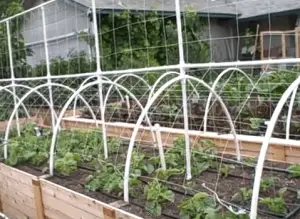If you are a keen gardener and wish that your garden could be a bit more productive, then perhaps you should look at the advantages of a raised bed garden to increase your crop yield. A lot of people are under the illusion that a raised bed garden, is only for those that do not have the space for a ‘real’ garden. This I am happy to say is a misconception, as the fact is there are many reasons why a raised bed vegetable garden could be worth your while in productivity and indeed labour saving ways.
Top 5 Advantages Of A Raised Bed Vegetable Garden
Easier to maintain: Since a raised bed is infilled with compost rather than soil which compacts; it is much easier to weed as there is no previous contamination with weed seeds.
Also as the compost does not compact like soil does, it is easy to lift out any weeds that do sprout up. The bed itself  is raised of the ground for anything up to two feet on average. This means that it is an ideal height for servicing and harvesting, without breaking your back in the process!
is raised of the ground for anything up to two feet on average. This means that it is an ideal height for servicing and harvesting, without breaking your back in the process!
The bed structure is only on average three feet across, this means again that it is easier to maintain compared to rows and rows of vegetables to hoe out in an open type garden.
More Productive: The raised bed garden is more productive for a few different reasons. The compost in the bed being raised off the ground, warms up faster than the soil, thereby giving you a longer growing season. Plants can be grown closer together as there is no need for allowing hoeing space to clear out the weeds; this means more productive use of the available space. Another reason for more productive plants, is simply that the nutrients are more concentrated in a raised bed, and the plants are not fighting weeds for food.
Free from Pests: Ok, maybe not entirely free from pests! However the truth is that it is a lot easier to keep slugs and other pests out of a raised bed vegetable garden than it is a traditional garden plot. For starters you are raised away from the ground, and so you have an immediate barrier against slugs. Simply attach some copper tape or strip along the edge of the bed and presto – no more slugs! (slugs will not cross copper as it reacts to their slime). Even the dreaded carrot fly is not so much of a pest if the bed is over 18″ high. If it isn’t then you can easily raise up the sides to make it so.
More accessible: Part of this is covered in the ‘easier to maintain’ link. However it is worth mentioning that a raised bed can make gardening possible again for someone who is getting a little infirm, or is otherwise unable to do all the bending over needed to maintain a traditional garden. If the beds are prepared properly with sufficient space between them for a wheelchair, then this makes gardening possible for anyone needing wheelchair access.
Versatile: The typical raised bed vegetable plot is six foot by four foot. This is an ideal size for managing as you can reach across the full width from both sides, and even the middle is accessable from the ends. On this plot you can grow a more diverse range of vegetables, because of the points brought up earlier. Also you can alter the bed by adding some simple framework that will give you a poly-tunnel effect, or simply cover the frame with bird mesh to protect your strawberries. Because the structure is usually timber, you have the advantage of being able to modify it quite simply.
One of the complaints I hear most against the use of a raised bed garden for growing vegetables, is simply the fact that it takes some money and effort to construct and fill with compost.
This sounds like a legitimate complaint – until you weigh up the advantages once that initial effort is spent. Every garden technique takes time and effort, if you want to produce something that you can be proud of.
The raised bed vegetable garden brings you back the rewards of that initial effort, many times over a number of years; and so in my mind it is a no-brainer to use this method whenever possible if you want to increase productivity and at the same time reduce the man-hours sweating over a vegetable patch!
brings you back the rewards of that initial effort, many times over a number of years; and so in my mind it is a no-brainer to use this method whenever possible if you want to increase productivity and at the same time reduce the man-hours sweating over a vegetable patch!

 is raised of the ground for anything up to two feet on average. This means that it is an ideal height for servicing and harvesting, without breaking your back in the process!
is raised of the ground for anything up to two feet on average. This means that it is an ideal height for servicing and harvesting, without breaking your back in the process!  brings you back the rewards of that initial effort, many times over a number of years; and so in my mind it is a no-brainer to use this method whenever possible if you want to increase productivity and at the same time reduce the man-hours sweating over a vegetable patch!
brings you back the rewards of that initial effort, many times over a number of years; and so in my mind it is a no-brainer to use this method whenever possible if you want to increase productivity and at the same time reduce the man-hours sweating over a vegetable patch!